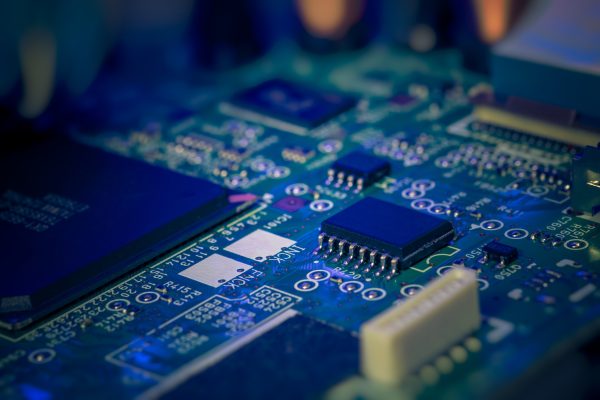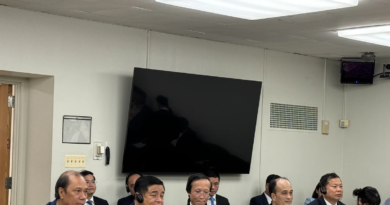Semiconductor Agreement at Japan-US Summit – The Diplomat – The Diplomat
Read The Diplomat, Know The Asia-Pacific
The two countries move forward with cooperation, despite some diverging interests.
The summit meeting between Japan and the United States early last month produced agreements in a number of areas, including closer command and control in the defense field and cooperation in space development. Several points were also agreed in the field of semiconductors, currently a focus area for Japan. In the 1980s, Japanese semiconductor makers supplied half the global market, but today they account for only about 10 percent, with the most technologically advanced semiconductors being made in Taiwan and South Korea. During the COVID-19 pandemic, the United States faced a semiconductor supply shortage, which brought home the vulnerability of the semiconductor supply chain.
Especially noteworthy at the recent summit were the references to “current-generation and mature-node (legacy) semiconductors.” The semiconductor export restrictions on China imposed by the United States in October 2022 mainly target advanced semiconductors (14-16 nanometer nodes), and aim to prevent China from using cutting-edge chips to develop the field of AI, as there is a risk of diversion to military AI. However, the future Japan-U.S. agenda will focus on legacy semiconductors, not advanced semiconductors.
The reason for this is that the fact sheet for the summit argues for a need to “address supply chain vulnerabilities, such as those posed by non-market policies and practices.” This may be understood as China supporting industries that manufacture legacy semiconductors via state subsidies rather than market principles, thus producing legacy semiconductors in excess of global market demand with the aim of creating a state of overcapacity and lowering prices to eliminate semiconductor industries in other countries.
Legacy semiconductors are used in a variety of products, such as automobiles and general home appliances, so that their absence would have a significant impact on daily life. During the pandemic, a combination of factors disrupted many aspects of daily life, such as delays in the supply of legacy semiconductors, delays in automobile deliveries, and an inability to repair water heaters. If China maintains its overcapacity and achieves a monopoly in legacy semiconductors, the supply chains of Japan and the United States will inevitably become extremely vulnerable.
In light of these concerns, Japan and the United States have already commenced discussions about legacy semiconductors initiatives in the U.S.-Japan Economic Policy Consultative Committee (our economic “2+2”). When it comes to regular, however, the two countries seem to have different attitudes.
For the United States, a Chinese monopoly in the area of legacy semiconductors would signify supply chain vulnerability and pose a risk to many American companies that use them. For Japan on the other hand, aggressive Chinese investment in legacy semiconductors would lead to heightened demand for semiconductor manufacturing equipment and semiconductor materials, which would in part favor Japanese companies. Moreover, the availability of low-cost legacy semiconductors is not a bad thing for Japan, as it is struggling with high import prices caused by the weak yen.
Moreover, in the case of advanced semiconductors, because the United States made a security-related request to prevent the development of military AI, Japan has also joined the American export restrictions and added 23 items, including semiconductor manufacturing equipment, to the Export Trade Control Ordinance (albeit without targeting any specific countries). However, even if legacy semiconductors are used for military purposes, they have a wide range of civilian uses, so it makes little sense to tighten export controls on security grounds. As such, it may be difficult to reach an agreement between Japan and the United States on economic “2+2.”
Although Japan and the United States have different attitudes toward legacy semiconductors, the two countries are in accord when it comes to advanced semiconductor development. In particular, research into next-generation semiconductors and advanced packaging is essential for establishing future technological leadership and dominance in the semiconductor sector, so this is an area where progress in Japan-U.S. cooperation can be expected. New breakthroughs in technology will be needed as the miniaturization of semiconductors approaches its physical limits, such as improved semiconductor capabilities through the stacking and development of chiplets that combine logic semiconductors and memory, which could yield semiconductors for AI.
In Japan, Rapidus was established as an advanced semiconductor manufacturer, and in cooperation with IBM, it seeks to reflect the results of such research and development in actual products. Furthermore, American companies are participating in a partnership that focuses on IOWN, technologies that combine optical and electronic aspects developed by NTT in Japan.
Meanwhile, Japan and the United States are investing in the development of human resources for advanced semiconductor research, likely creating bases to supply skilled workers, who are in short supply worldwide. In this way, the Japan-U.S. Summit Meeting has entered a phase of encouraging cooperation on advanced semiconductors while coordinating in the area of legacy semiconductors based on their own national interests.
Understand the Asia-Pacific’s biggest issues with a The Diplomat subscription.
Already have an account? .
The summit meeting between Japan and the United States early last month produced agreements in a number of areas, including closer command and control in the defense field and cooperation in space development. Several points were also agreed in the field of semiconductors, currently a focus area for Japan. In the 1980s, Japanese semiconductor makers supplied half the global market, but today they account for only about 10 percent, with the most technologically advanced semiconductors being made in Taiwan and South Korea. During the COVID-19 pandemic, the United States faced a semiconductor supply shortage, which brought home the vulnerability of the semiconductor supply chain.
Especially noteworthy at the recent summit were the references to “current-generation and mature-node (legacy) semiconductors.” The semiconductor export restrictions on China imposed by the United States in October 2022 mainly target advanced semiconductors (14-16 nanometer nodes), and aim to prevent China from using cutting-edge chips to develop the field of AI, as there is a risk of diversion to military AI. However, the future Japan-U.S. agenda will focus on legacy semiconductors, not advanced semiconductors.
The reason for this is that the fact sheet for the summit argues for a need to “address supply chain vulnerabilities, such as those posed by non-market policies and practices.” This may be understood as China supporting industries that manufacture legacy semiconductors via state subsidies rather than market principles, thus producing legacy semiconductors in excess of global market demand with the aim of creating a state of overcapacity and lowering prices to eliminate semiconductor industries in other countries.
Legacy semiconductors are used in a variety of products, such as automobiles and general home appliances, so that their absence would have a significant impact on daily life. During the pandemic, a combination of factors disrupted many aspects of daily life, such as delays in the supply of legacy semiconductors, delays in automobile deliveries, and an inability to repair water heaters. If China maintains its overcapacity and achieves a monopoly in legacy semiconductors, the supply chains of Japan and the United States will inevitably become extremely vulnerable.
In light of these concerns, Japan and the United States have already commenced discussions about legacy semiconductors initiatives in the U.S.-Japan Economic Policy Consultative Committee (our economic “2+2”). When it comes to regular, however, the two countries seem to have different attitudes.
For the United States, a Chinese monopoly in the area of legacy semiconductors would signify supply chain vulnerability and pose a risk to many American companies that use them. For Japan on the other hand, aggressive Chinese investment in legacy semiconductors would lead to heightened demand for semiconductor manufacturing equipment and semiconductor materials, which would in part favor Japanese companies. Moreover, the availability of low-cost legacy semiconductors is not a bad thing for Japan, as it is struggling with high import prices caused by the weak yen.
Moreover, in the case of advanced semiconductors, because the United States made a security-related request to prevent the development of military AI, Japan has also joined the American export restrictions and added 23 items, including semiconductor manufacturing equipment, to the Export Trade Control Ordinance (albeit without targeting any specific countries). However, even if legacy semiconductors are used for military purposes, they have a wide range of civilian uses, so it makes little sense to tighten export controls on security grounds. As such, it may be difficult to reach an agreement between Japan and the United States on economic “2+2.”
Although Japan and the United States have different attitudes toward legacy semiconductors, the two countries are in accord when it comes to advanced semiconductor development. In particular, research into next-generation semiconductors and advanced packaging is essential for establishing future technological leadership and dominance in the semiconductor sector, so this is an area where progress in Japan-U.S. cooperation can be expected. New breakthroughs in technology will be needed as the miniaturization of semiconductors approaches its physical limits, such as improved semiconductor capabilities through the stacking and development of chiplets that combine logic semiconductors and memory, which could yield semiconductors for AI.
In Japan, Rapidus was established as an advanced semiconductor manufacturer, and in cooperation with IBM, it seeks to reflect the results of such research and development in actual products. Furthermore, American companies are participating in a partnership that focuses on IOWN, technologies that combine optical and electronic aspects developed by NTT in Japan.
Meanwhile, Japan and the United States are investing in the development of human resources for advanced semiconductor research, likely creating bases to supply skilled workers, who are in short supply worldwide. In this way, the Japan-U.S. Summit Meeting has entered a phase of encouraging cooperation on advanced semiconductors while coordinating in the area of legacy semiconductors based on their own national interests.
SUZUKI Kazuto is a professor at the Tokyo University Graduate School of Public Policy and director of the Institute of Geoeconomics, the International House of Japan.
Get briefed on the story of the week, and developing stories to watch across the Asia-Pacific.

